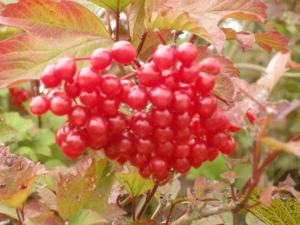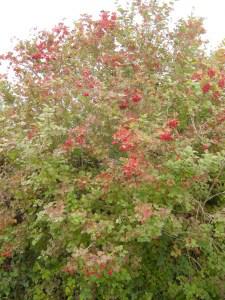
Viburnum opulus berries (08/09/2011, Cambridge)
Position: Full sun to light shade
Flowering period: Spring/Summer
Soil: Well drained, moist
Eventual Height: 5m
Eventual Spread: 4m
Hardiness: USDA Zones 3a – 8b
Family: Caprifoliaceae
Viburnum opulus is a deciduous shrub growing up to 5m tall. It’s leaves are three lobed and can be opposite, simple or palmate. They are 5-10 cm in size, with a rounded base, coarsely serrated margins and a wrinkled surface. The dark green foliage turns red in autumn. In early summer this plant gives rise to 10cm corymbs of white, fragrant hermaphrodite flowers located at the top of the stems. These are followed by clusters of bright red drupes 7-10 mm in diameter, each of which contains a single seed.
V.opulus, commonly known as the Guelder Rose or European Cranberrybush, is a species of Viburnum native to Europe and Asia, including the UK. Viburnum opulus is the National symbol of the Ukraine and it is mentioned throughout Ukrainian folklore in their songs, artworks and embroidery . It’s symbolic roots can be traced back to Slavic paganism of millennia ago.
The name Viburnum is derived from the Latin name for Wayfaring tree, another shrub of the Viburnum genus. Opulus is derived from Latin name for a type of Maple, in reference to the shape of this shrub’s leaves.

Viburnum opulus (08/09/2011, Cambridge)
The landscape architect may find this shrub a valuable component of a native mixed hedge due to its great wildlife benefit. It may also be used as part of a native woodland planting scheme, forming a part off the understory component.
This plant prefers sandy, loamy and clay soils overall tolerating most soil types. The plant will grow in wide soil pH, from acid to alkali, it will tolerate very alkali soils.
Ecologically this shrub is a great source of nutrition for birds who inadvertently aid the plants dispersal. The flowers are are a great source of nectar for pollinating insects including hover-flies.
Maintenance: Requires little to no maintenance. When grown as part of a mixed hedge it will be managed as part of the hedge maintenance regime.




